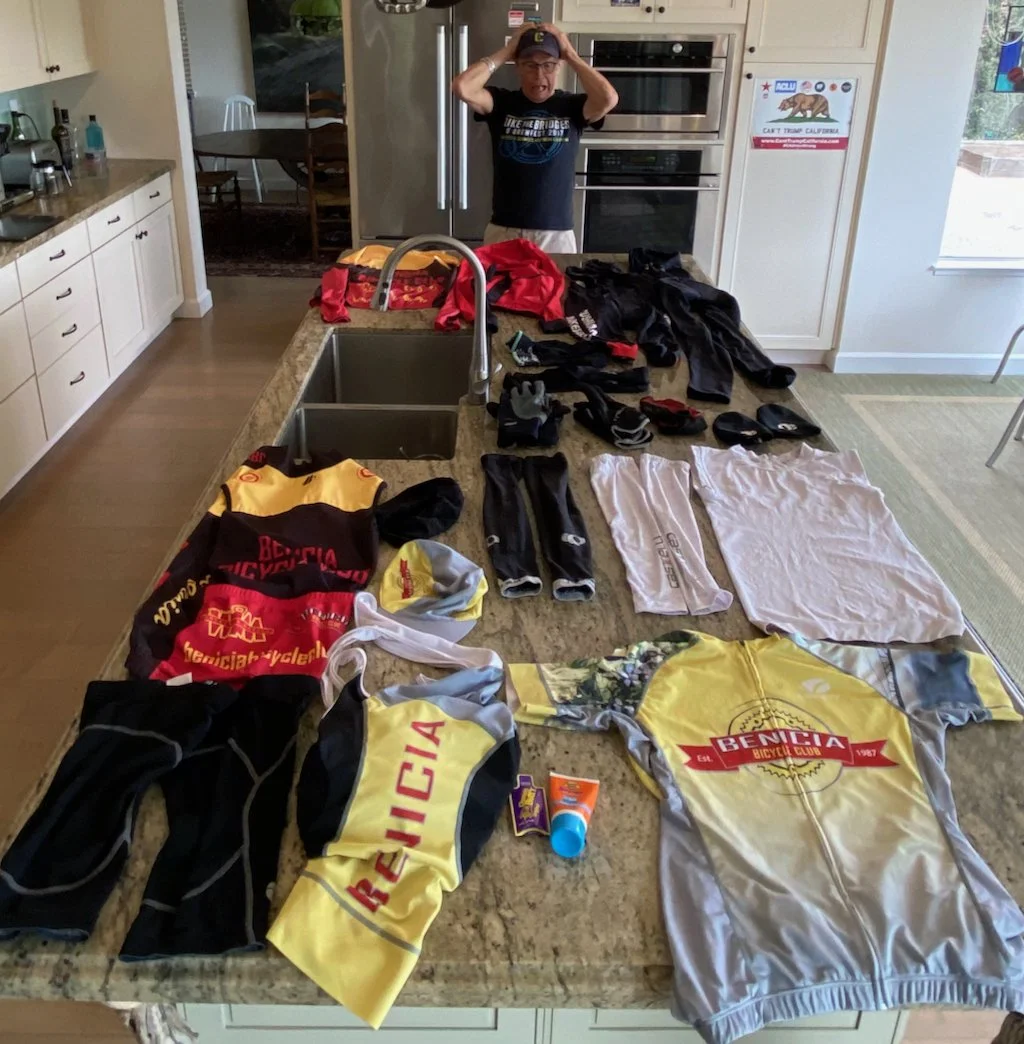Bike Clothing De-mystified
by Craig Snider
When I first began riding with the Benicia Bicycle Club I had a couple of pairs of standard black bike shorts, two bike jerseys, and some fingerless gloves. That was fine for warm summer days, but I would need more bike clothing for the rest of the year. As the days grew shorter and colder, I remember stressing about choosing the right clothes for the day. Overdressed: too hot!-underdressed freezing! Fortunately, after 9 years commuting by bike, 18 years with BBC, and 4 years of bike racing, I figured it out. In this article, I’ll share my insights about bike clothing for year-round riding. Much about bike clothing is a personal choice, but some items are essential.
Before I choose my bike clothes for the day I check the day’s temperature trend and choose my bike clothes accordingly. Each of us has a different comfort level when it comes to temperature. I tend to be a cold weeny and would rather be a little warm than cold.
As with any outdoor activity, it’s important to dress in layers. However, there’s little space to stash extra clothing in jersey pockets or elsewhere on a bike; so be judicious about how much you wear.
So, here is my toe to head take on essential bike gear.
Feet. This is the easiest decision. I haven’t found a pair of socks that won’t work, but I can get a snugger fit for my bike shoe with a thicker sock. I like a low-cut sock for the summer and a higher cut for the winter. In addition, on cold days (below 45 degrees), I use toe covers on my bike shoes and booties on really cold days (30’s). Tip: a cheap way to keep your toes warm is to cut a few inches of the corner from a grocery vegetable bag and place this over the end of your sock and slide it into your shoe.
Legs. Shorts come either bibbed (shoulder straps) or regular. I like bib shorts because they stay up better, look better and keep the chamois in position. However, some folks do fine with regular bike shorts. In cool weather (below 55 degrees) I use knee warmers which can be removed as the day gets warmer. One can also wear leg warmers that reach the ankles, but I prefer bib tights or bib knickers, with a thicker fabric, on rides below 45 degrees. BTW, I don’t wear underwear under my shorts and smearing chamois butter on the pad can prevent chafing on longer rides. I always pack some chamois butter just in case.
Torso. In the summer, I often wear only my short sleeve jersey, while in winter I like to wear a sleeveless base layer between the jersey and the bibs. On cold days (45-60), I usually add a wind vest to fight the wind chill until the day warms up. Colder, and I like a long-sleeved breathable windbreaker. Windbreakers are important if there’s a chance of rain since it buys time to get home if you’re caught in a rainstorm. Not waterproof, but the shell is enough to keep off the wind chill and stall rain penetration. The vest and windbreaker are made of thin fabrics so they can be removed and stuffed in a pocket or fanny pack as the day (and you) warm-up. On colder days I find a bike jacket with insulation works well, however, these are bulky and hard to stow anywhere if you get too warm, I only use this option when I’m certain the temperature will stay cold for the full ride. An alternative is a long-sleeved winter jersey made of thicker material. Paired with a base layer, you may not need a jacket. Tip: a cheap way to stave off cold is to flatten a plastic grocery bag under the front of your shirt. Consider base layers made of a Merino wool blend as this fabric does an excellent job keeping you warm, but also breathes well so you won’t overheat. Also an excellent material for socks.
Arms. Arm warmers are great and can be easily removed and stowed as the day warms up. I like a black arm warmer since it will absorb a little heat on a cold sunny day. For much of the year I also pack some arm coolers. These are usually white with thinner fabric than arm warmers. I use them when the UV light is stronger, especially spring, summer, fall. Our arms are otherwise totally exposed to the sun’s harmful rays while riding.
Hands. I have a lot of gloves, but three types are essential. These include fingerless gloves for warm days, lightweight full-fingered gloves for colder days, and thick, well insulated, gloves for really cold days.
Eyes. Being nearsighted, I wear prescription sunglasses or photo grays. I like the photo grays because they lighten up when I go indoors for coffee and pastries.
Head. Being bald, I’m always thinking about headgear. Head sweats or bike hats are fine for warmer days to prevent sweat from running into your eyes. On cold days a thicker fleece helmet liner that covers the ears is preferred
Cost. The full bike-riding wardrobe above can get expensive, especially our custom BBC clothing. But a search of Google shopping reveals most of these items can be purchased for under $30. And don’t shy away from used gear (check eBay.) I have bike clothes over 10 years old that still look new. I’ve also found some great bargains at The Clymb and Sierra Trading Post.
We plan to keep our BBC kit largely the same color/pattern for several years. Consider buying a club item or two at order time and pick up more components in future orders as your budget allows.
Craig’s List:
Socks
Toe Covers
Booties
Bib Shorts
Bib Tights
Bib Knickers
Knee Warmers
Short-Sleeve Jersey
Sleeveless Base Layer
Wind Vest
Windbreaker (long-sleeved)
Bike Jacket (insulated)
Arm Warmers
Arm Coolers
Fingerless Gloves
Light Weight Full-Fingered Gloves
Thick Full-Fingered Gloves
Sunglasses
Head Sweats/Bike Hat
Helmet Liner (light fleece) that covers the ears
Sunscreen
Chamois Butter
Don’t forget the sunscreen! Be careful around the eyes so sweat will not get the sunscreen into your eyes. Be sure to use lip balm having sunscreen too.


